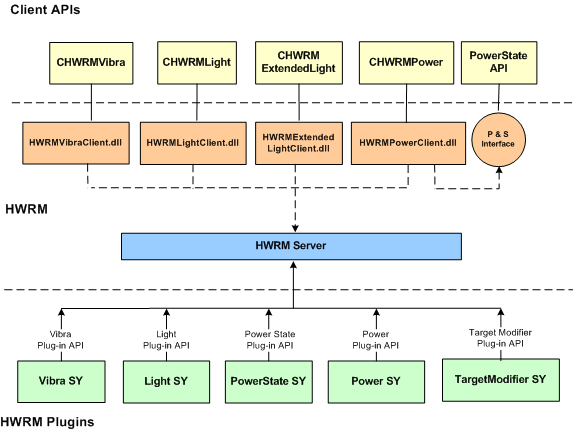Hardware Resource Manager Overview
Hardware Resource Manager (HWRM) is a client-server solution, which utilizes ECom plug-ins to achieve device independency. ECom plug-ins convert the client requests into the hardware control commands.
Purpose
HWRM performs the following functions:
Required background
Knowledge of the client-server architecture, asynchronous processing, and active objects feature of the Symbian system model architecture.
HWRM architecture
HWRM is made up of the following components:
Client APIs
HWRM provides client APIs that can control various hardware elements. It also provides callback pointers, so that the client applications can register to receive notification on the hardware status changes. Refer to the tutorials for information on how to use client APIs. Client APIs are useful for both application developers and the handset manufacturers.
HWRM server
HWRM server uses plug-in handlers to forward the client API requests to appropriate plug-ins. The client application communicates with HWRM server through the client APIs (Light API, Vibra API, and Power API). HWRM server defines the observer classes, which provide the callback pointers.
The server calls CHWRMPluginService::ProcessCommandL() function to forward the client requests to plug-ins. An ongoing ProcessCommandL() is cancelled by HWRM server using CHWRMPluginService::CancelCommandL(). The plug-ins process the server's request and pass the response by calling CHWRMPluginCallback::ProcessResponseL() function. The MHWRMPluginCallback::EventL() method is used to communicate various events that takes place in the plug-ins.
HWRM uses the central repository to store the various values and settings such as the light intensity, duration and delays.
HWRM plug-ins
HWRM plug-ins convert client requests to hardware control commands.
HWRM forwards the client requests to the plug-ins through the plug-in APIs. All events are notified to HWRM server using MHWRMPluginCallback::EventL() method. After executing each command, the server is notified. The notification is accompanied by an error code. HWRM server passes these error codes to the clients. When the request is completed successfully, KErrNone is returned. If an error occurs while executing a command, such as target hardware not implemented or not ready, the corresponding error code is returned. Refer to the Hardware Resource Manager Plug-ins section for more details.
APIs
The HWRM provides the following client APIs and plug-in APIs:
Typical use cases
HWRM is used for the following:
Copyright ©2010 Nokia Corporation and/or its subsidiary(-ies).
All rights
reserved. Unless otherwise stated, these materials are provided under the terms of the Eclipse Public License
v1.0.
